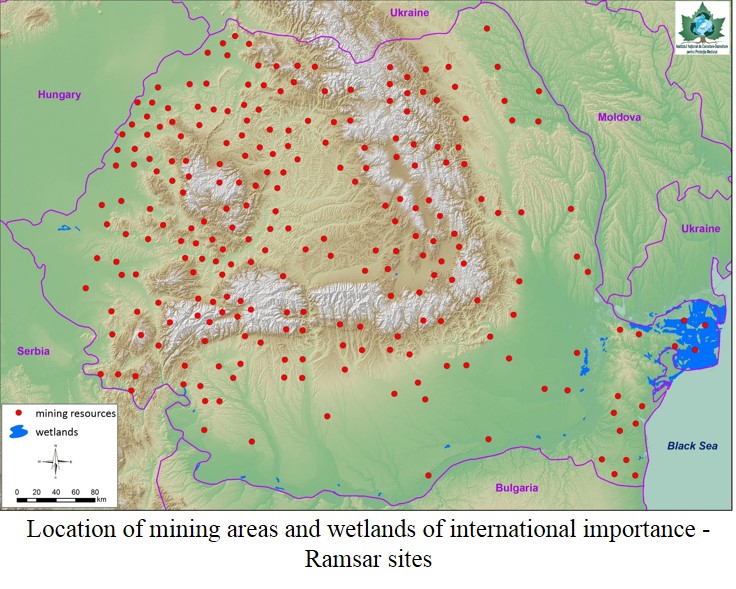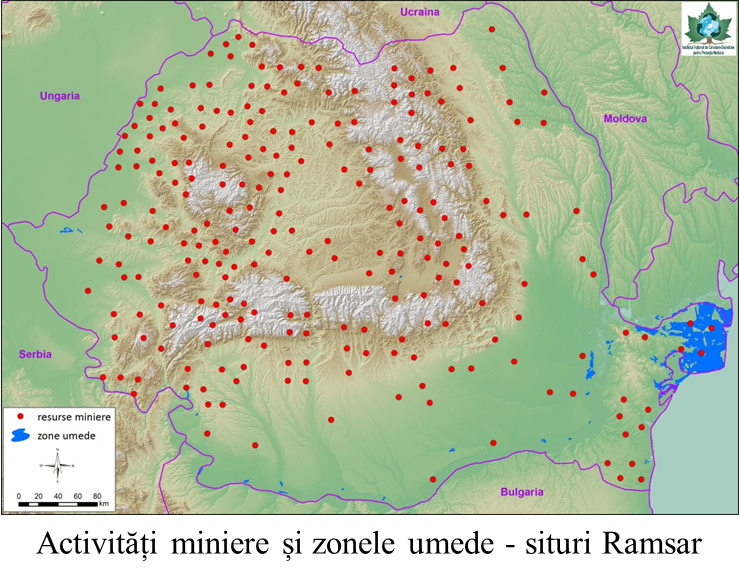- Home
- About Us
- Scientific Departments
- Laboratories Department
- Environmental Quality Assessment
- Waste Management
- Natural and Technological Hazards
- Numerical Modeling And Geographic Information Systems
- Impact of Built Environment and Nanomaterials
- Engineering For Environmental Protection And Impact Assessment
- Climate Change And Sustainable Development
- Biodiversity And Ecosystem Dynamics Department
- Management Of Natural Resources And Green Energy
- Research activity
- Projects
- Reports
- News
- Contact
National register regarding secondary reserves of raw materials with economic importance resulted from mining residues

The project is divided into 5 stages:
1) The logistical and technical preparation of the project;
2) Updating information on European legislation in the field of secondary resources from mining waste;
3) Current situation in our country regarding the policies for the exploitation of the secondary raw material reserves;
4) Elaboration of documentation on exploitable mining tailings;
5) Elaboration of the documentation on the secondary reserves of raw materials with economic importance resulted from the mining residues.
Multidisciplinary teams bringing together experts in the field of geology, materials science and engineering, chemical engineering, environmental engineering, equipment design are involved in this project, ensuring thus its success.
According to the Strategic Implementation Plan for the European Innovation Partnership on Raw Materials, which synthesizes the policies regarding the mineral resources, the coherent development of this area is based on three major pillars:
a) Ensuring access to raw materials for all major players in the European economy;
b) Determining the conditions for a sustainable supply of raw materials;
c) Encouraging the efficient use of resources and promoting resource efficiency and recycling to reduce raw material consumption and dependence on imports outside the European area.
Taking into account the continued demand for mining products, at European level are encouraged the initiatives aiming a sustainable, smart and inclusive growth and innovation. Accordingly, the development of best practices and technologies for the collection and treatment of waste, and the improvement of access to waste statistics and material flows to support research and innovation are encouraged within UE. Thus, this project aims to create a national database on secondary reserves of mining waste materials so that Romania can participate in the activities of the European platform and benefit from its expertise. Mining residues are of interest due to their negative impact on the environment as evidenced by the formation of acid waters, heavy metals pollution (Pb, Cu, Zn, Cd, Hg) and metalloids (As, Sb), mechanical instability phenomena, blocking of agricultural or built-up areas, modification of the landscape in areas with tourism potential. However, these residues have the potential for industrial capitalization as secondary mineral resources by recovering the useful basic elements for which the mines were opened (Au, Ag, Cu, Pb, Zn, Fe, Mn, W, Mo) or elements that have recently gain interest from the industry (Ge, In, Te, Cd, Sb), the use of gangue elements (quartz, feldspar, clay minerals) or the use of mining residues to ameliorate the deficient solutions (eg in the case of some coal mines tailings).
- Partners
CO – National Research & Development Institute for Non-Ferrous and Rare Metals (IMNR)
P1 – Geological Institute of Romania (IGR)
P2 – Research and Development National Institute for Metals and Radioactive Resources (INCDMRR – ICPMRR)
P3 – National Institute for Research and Development in Environmental Protection (INCDPM)
P4 – National Institute for Research & Development in Chemistry and Petrochemistry (ICECHIM)
P5 – COSFEL ACTUAL SRL - Project Coordinators
Eng. Deák György PhD. habil, Scientific Researcher I
- Period
14.11.2017 – 10.12.2018 - Financed via
Ministry of Research and Innovation
Obiectives
The general objective of the project is to produce a national register containing secondary resources of raw materials from mining residues that will allow for the repositioning of the mining sector considering the supply with mineral resources necessary for a sustainable development of the country under environmentally friendly conditions.
The specific objectives of the project include:
- Updating the integrated database on the secondary resources of raw materials from mining waste with an emphasis on tailings and tailings ponds during the project implementation period (one year). At least 20 representative areas will be sampled.
- Simulating (under technical-economic conditions) the processing of secondary resources (tailings ponds) in order to identify ways to make them more efficient, in environmentally friendly conditions, with emphasis on the study of the environmental impact considering the European legislation;
- Performing 3 case studies to ensure the rapid implementation of the project results;
- Organizing 2 national debates and 5 regional debates in representative areas to inform the public about the exploitation of secondary mining resources and to start the effective cooperation between institutions and authorities (ministries, relevant agencies, local organizations, chambers of commerce, NGOs, institutes and universities with concerns in the field, potential users).
Obtained Results
The implementation of the project determined the following results:
- Updated information regarding the European legislation on secondary resources from mining waste and the protection of areas of international importance;
- The SWOT analysis of the current Romanian exploitation policies of the secondary reserves of raw materials from mining waste;
- National database on secondary reserves of mining wastes;
- Inventory of mining waste areas, evaluation and characterization, technical and economic exploitation conditions, case studies;
- National and regional debates, including within scientific events.

Proiectul este structurat pe 5 etape:
- Pregătirea logistică și tehnică a proiectului;
- Reactualizarea informațiilor privind legislația europeană în domeniul resurselor secundare din reziduuri miniere;
- Situația actuală din țara noastră privind politicile de exploatare a rezervelor secundare de materii prime;
- Elaborarea documentației privind zonele cu reziduuri miniere exploatabile;
- Elaborarea documentației privind rezervele secundare de materii prime cu importanță economică rezultate din reziduuri miniere.
Pentru realizare acestui proiect sunt implicate echipe multidisciplinare care reunesc experți în domeniul geologiei, științei și ingineriei materialelor, inginerie chimică, ingineria mediului, proiectare echipament
Conform Planului Strategic de Implementare pentru Parteneriatul European pentru Inovare privind Materiile Prime care sintetizează politicile în domeniul resurselor minerale, dezvoltarea coerentă a acestui domeniu este bazată pe 3 piloni importanți:
- Garantarea accesului la materii prime a tuturor actorilor importanți pentru economia europeană;
- Determinarea condițiilor pentru o furnizare durabilă cu materii prime;
- Dinamizarea eficacității utilizării resurselor și promovarea reciclării cu scopul reducerii consumului de materii prime și dependenței de importuri din afara zonei europene.
În acest context, la nivel european sunt încurajate inițiativele ce au drept scop creșterea durabilă, inteligentă și favorabilă incluziunii și inovării, ținând cont de cererea continuă a produselor miniere. Așadar, este promovată dezvoltarea celor mai bune practici și tehnologii de colectare și tratament al deșeurilor, îmbunătățirea accesului la statistici privind deșeurile și fluxurile de materiale în vederea susținerii cercetării și inovării. Astfel, prezentul proiect își propune realizarea unei baze de date la nivel național privind rezervele secundare de materii prime din reziduuri miniere, astfel încât România să poată participa la activitățile platformei europene și beneficia de expertiza acesteia. Reziduurile miniere prezintă interes datorită impactului negativ al acestora asupra mediului evidențiat prin formare de ape acide, poluare cu metale grele (Pb, Cu, Zn, Cd, Hg) și metaloizi (As, Sb), fenomene de instabilitate mecanica, blocarea terenurilor agricole sau intravilane, modificarea peisajului în zone cu potențial turistic. Totuși, aceste reziduuri prezintă posibilitate de valorificare industrială ca resurse minerale secundare prin recuperarea elementelor utile de bază (Au, Ag, Cu, Pb, Zn, Fe, Mn, W, Mo) pentru care au fost deschise minele sau a unor elemente care au intrat recent în sfera de interes a valorificării industriale (Ge, In, Te, Cd, Sb), utilizarea elementelor de ganga (cuarț, feldspat, minerale argiloase) sau folosirea unor reziduuri miniere ca amelioratori pentru soluțiile sărace (de exemplu în cazul unor halde ale minelor de cărbuni).
- Parteneri
CO – Institutul Național de Cercetare-Dezvoltare pentru Metale Neferoase și Rare (IMNR)
P1 – Institutul Geologic al României (IGR)
P2 – Institutul Național de Cercetare-Dezvoltare pentru Metale şi Resurse Radioactive (INCDMRR – ICPMRR)
P3 – Institutul Național de Cercetare-Dezvoltare pentru Protecția Mediului (INCDPM București)
P4 – Institutul Naţional de Cercetare – Dezvoltare pentru Chimie si Petrochimie (ICECHIM)
P5 – COSFEL ACTUAL SRL - Responsabili de Proiect
Dr. ing. habil. Deák György, CS I
- Perioada de desfășurare
14.11.2017 – 10.12.2018 - Finanțat prin
Ministerul Cercetării și Inovării
Obiective
Obiectivul general al proiectului constă în realizarea unui registru național al resurselor secundare de materii prime rezultate din reziduurile miniere care să permită repoziționarea domeniului minier din perspectiva asigurării resurselor minerale necesare unei dezvoltări durabile a țării, în condiții prietenoase cu mediul.
Obiectivele specifice ale proiectului se referă în principal la:
- Reactualizarea într-o perioadă de un an, pe parcursul derulării proiectului, a bazei de date integrate privind resursele secundare de materii prime din reziduuri miniere, cu accent pe halde și iazuri de steril. Se vor eșantiona cel puțin 20 de zone reprezentative;
- Simularea în condiții tehnico-economice, a procesării resurselor secundare de materii prime (iazuri de steril), cu scopul identificării modalităților de eficientizare a acestora, în condiții prietenoase cu mediul, cu accent pe studiul impactului de mediu în strânsă concordanță cu legislația europeană;
- Realizarea a 3 studii de caz care să asigure implementarea rapidă a rezultatelor proiectului;
- Organizarea a 2 dezbateri naționale și 5 dezbateri regionale în zone reprezentative, cu scopul informării publicului cu privire la activitățile de exploatare a resurselor secundare din reziduuri miniere și al demarării cooperării eficiente între instituții și autorități (ministere, agenții cu preocupări în domeniu, organizații locale, camere de comerț, ONG-uri, institute și universități cu preocupări în domeniu, potențiali utilizatori).
Rezultate obținute
Implementarea proiectului a determinat obținerea următoarelor rezultate:
- Informații reactualizate privind legislația europeană în domeniul resurselor secundare de materii rezultate din reziduuri miniere și protejarea zonelor de importanță internațională;
- Analiza SWOT a situației actuale din țara noastră privind politicile de exploatare a rezervelor secundare de materii prime rezultate din reziduuri miniere;
- Bază de date națională privind rezerve de reziduuri miniere;
- Inventarierea zonelor de reziduuri miniere, evaluare și caracterizare, condiții tehnico-economice de exploatare, studii de caz;
- Dezbateri naționale și regionale, inclusiv în cadrul unor sesiuni științifice.
